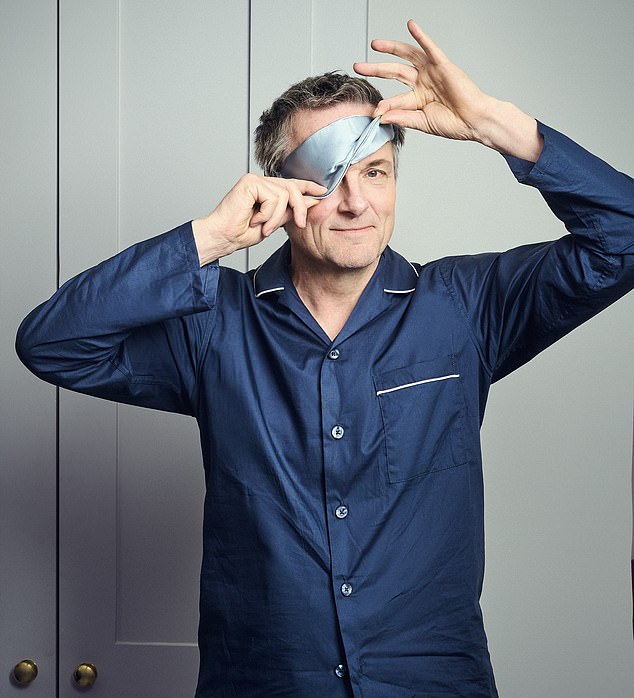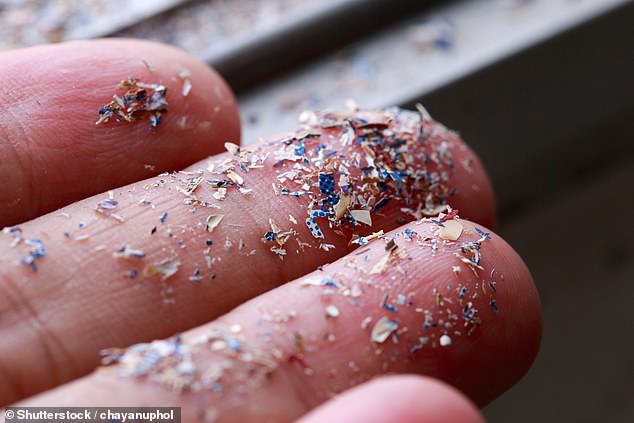One of the perks of being a TV host, especially if you’re someone who likes to experiment, is that you find out a lot of unexpected things about yourself.
Although this is not all good news. 13 years ago, I discovered through a random blood test that I had type 2 diabetes and went on a journey (with camera crew in tow) to see if I could cure myself.
Recently I’ve been doing a series on sleep and discovered why I have insomnia – and that I have another life-shortening condition, obstructive sleep apnea (OSA).
OSA is incredibly common, with up to ten million Britons affected. Basically, it means you repeatedly stop breathing while you sleep because your throat and tongue muscles relax and block your airway.
Your brain, ever alert, wakes you up just enough for you to switch sides and start breathing again. This can happen more than 30 times an hour. Those affected tend to make gasping, snorting or choking noises as they try to get air into their lungs.

Dr. Michael Mosley discovered that his insomnia is caused by obstructive sleep apnea – a condition in which a person repeatedly stops breathing while sleeping
Not surprisingly, if you have OSA, you’re likely to feel really tired during the day, even if you’ve slept for eight hours or more, and may suffer from memory lapses. But it can also have a terrible impact on your long-term health. But less than 15 per cent of Britons who have it know they have it, let alone get any treatment.
While I knew I slept poorly and often felt tired during the day, I thought it was because I would regularly wake up at night and have trouble getting back to sleep.
Then last year I went to Australia to do a series on sleep: this included taking part in a revolutionary trial run by Flinders University at its Sleep Health Institute in Adelaide.
The idea was to take 30 people who have struggled with their sleep for years and use cutting-edge technology to diagnose their problems – then see if a tailored sleep program could help.
We all had to spend a night being observed in a sleep lab – we had electrodes attached to our heads to record our sleep, and we were also filmed and observed during the night.
Professor Danny Eckert, an expert in sleep disorders who led the team, told me that my data showed that I had moderately severe OSA, and it was particularly bad when I was lying on my back.
This was a nasty shock because, in addition to making you feel tired, it increases your risk of heart disease and stroke if you have untreated OSA.
And it turned out I wasn’t alone. A third of the volunteers in the trial were found to have OSA, and many, like me, were blissfully unaware of it.
So what are the risk factors for OSA? Most people who have it also smoke, drink (both cause your upper airway muscles to relax), or are significantly overweight and have a large neck – but none of these are true for me.
However, OSA is also more common in older men (tick) and can have a strong genetic component (tick, my dad had it).
As for treating it, while weight loss can be helpful, my BMI is already in the healthy range.
The team knew I wasn’t keen on a CPAP machine (which involves wearing a mask while you sleep that pushes air into your airway to keep it open), so they suggested some alternatives.
First, I was fitted with a mandibular advancement device, a type of mouth guard that pushes your jaw forward. This prevents your tongue from falling back and blocking your airway.
The second device they recommended was a strap worn around the neck that detects when you’re lying on your back—it then emits a buzzing sound to alert you to switch sides.
You can also try cheaper, low-tech approaches, as suggested by the NHS, such as sewing a tennis ball into the back of your pajamas or buying a bed wedge. But it turns out my sleep problems weren’t limited to OSA.
All the experimenters had to swallow an electronic pill which measured our core body temperature. This fluctuates over the course of 24 hours, but is usually lowest around 04.00, when you should be most sleepy.
But my body temperature is at its lowest around 01:00, three hours earlier than usual.
That could explain why I have a hard time staying awake well past 10am. 10 p.m., and why I, when I wake up at 3am, having such a hard time falling back asleep (my body clock thinks it’s dawn and time to wake up).
So the answer for me was to expose myself to bright light last thing at night.
As Professor Leon Lack, a psychologist at Flinders explained, this would help shift my body clock later and mean I was less likely to wake up at 3am and feel so bright and alert.
He also recommended that I try ‘bed time restriction therapy’ which in my case involved going to bed at 23 every evening and get up around 5.30 every morning for at least four weeks.
The idea is to teach your brain to associate being in bed with sleep, rather than lying awake. As you begin to sleep better, you can gradually increase the time you spend in bed.
It’s hard, at least at first, but is also an effective way to treat long-term insomnia (for more details on all this, see my new book, 4 Weeks to Better Sleep).
All of this has made a huge difference to my sleep; I have now got my OSA and insomnia under control and as a result I feel full of energy during the day.
Best of all, I can participate in and enjoy family activities where previously I might have felt so drained that I withdrew into myself.
As for the rest of the trial participants, more than 80 percent experienced life-changing improvements in their sleep.
One said to me: ‘I’m sleeping now, that’s so good it should be illegal.’
The results of the trial were so impressive that they will be published in a leading sleep journal later this year.
Humanity has had a long battle with nasty microbial infections, but we also owe a lot to microbes: without them turning sugar into alcohol, there would be no beer or wine.
And it seems we can thank them for our ability to think, too.
A study by the Cambridge Institute of Science found that our ability to produce myelin (the insulation around our nerves which allows messages to travel quickly to and through our brains) is thanks to a virus that infected a relative of ours in tens of thousands of years. since. Something to consider when you get your next cold.
Like many others, I am increasingly concerned about the growing threat posed by plastic pollution.
It’s not just the plastic bags that litter the hedges when I go for walks, but microplastics, the tiny particles of the stuff that are literally everywhere and increasingly perceived as a major health risk.
Direct evidence for this came from a study published in the New England Journal of Medicine. Researchers in Italy examined samples of plaque (the fatty deposits that line your blood vessels) from patients who had recently had surgery to remove it.


Microplastics are tiny particles of plastic that are everywhere and are increasingly seen as a major health risk
Nearly 60 percent of the samples contained microplastics—plus, patients with microplastics in their plaque were nearly five times more likely to have a heart attack, stroke, or die in the 34 months after surgery.
The researchers believe that the microplastics cause chronic inflammation, which in turn causes heart disease and stroke.
Analysis revealed that most of the particles were made of polyethylene, typically found in food packaging and plastic shopping bags; or polyvinyl chloride (PVC), which is used in plastic bottles.
There is not much you can do to avoid microplastics, although at home my wife Clare and I avoid heating or microwaving anything in a plastic container. We also drink tap water instead of bottled.
You can also boil tap water for a few minutes and then filter it after it cools. A study in the journal Environmental Science & Technology Letters found that this removed more than 80 percent of microplastics, especially if the water is hard.
This is because boiling releases calcium carbonate (ie lime) from the water, which then traps the microplastics, which you can then filter out.
